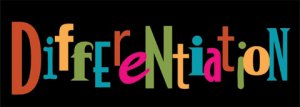Posts tagged ‘differentiated instruction’
Does One Size Fit All??
In Chapter 4 of Julie D. Ramsay’s “Can We Skip Lunch and Keep Writing?” Collaborating in Class and Online, Grades 3-8, Ramsay talks about how she personally differentiated instruction for a group of her fifth-grade students who struggled with oral language. She uses a free tool called Jing, which lets the user create a narrated video. The students were hesitant at first upon hearing they would have to narrate their project, but Ramsay assured them they would be able to take their time and do their narrations in privacy, so that they could get their very best recordings. When Ramsay’s students completed their project, they were faced with an obstacle – not being able to use it in the classroom, due to the program being blocked by the school district’s server. Although the students were unable to show their video in class, the student’s were still very excited to have been the first ones in the class to use this new technology, and to successfully complete a project using it. The project gave these students new momentum when it came to their oral reading.
While Ramsay was trying to figure out a new way to use this type of software in her classroom, she was introduced to VoiceThread. VoiceThread allows the user to create a slideshow of images, text, photographs, videos, and narration. This program works great for a collaborative project, because you can share your slideshow with others, who can then comment on your work through voice, text, audio file, or video. Ramsay and her students did a collaborative poetry project about “going green”. She wanted her students to comment on the work of others, and when doing so Ramsay was able to target a few groups of students who needed more help in particular areas of oral or written language. She differentiated her instruction to fit the students’ needs, which dealt with things like articulation, grammar, and using descriptive words and figurative language.
While doing these projects, Ramsay realized how important it was to tailor her instruction to meet the needs of the learner. Differentiating instruction means that you observe and understand the similarities and differences between learners, and you use this information to plan instruction. In a classroom, there will be a variety of differences between the students and how they learn. Knowing how these students learn will help ensure that they will succeed in your classroom. And not only does differentiating instruction deal with tailoring the instruction to fit the students’ needs, but it also means not doing the same things over, and over, and over again. Just look at the cartoon below to see how important this is as well:
Below are 9 ways in which you can differentiate reading instruction. Keep in mind that these don’t just stop at reading, they can be used in some way for all of the other content areas that we as teachers are responsible for teaching. (These tips come from “Differentiating Reading Instruction” by Laura Robb – and you can get more information on her tips by clicking on the above link).
- Make your read alouds a common teaching text.
- Teach with diverse materials.
- Organize for instruction so you meet all reading levels.
- Value independent practice reading.
- Show students how to construct meaning while reading.
- Encourage discussion.
- Write to explore, think, learn, and improve comprehension.
- Use ongoing assessments to support each student.
- Plan your units carefully.
As a future teacher, there is one important thing (along with the thousands of other important things) that I believe I need to remember when it comes to becoming a successful teacher. All students are not the same. In order to help them succeed, I need to be prepared with my lessons and be ready to teach all levels of students, including those who are at grade level, below grade level, and above grade level. Remember:

